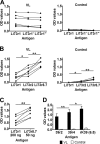Upregulated expression of B-cell antigen family tandem repeat proteins by Leishmania amastigotes
- PMID: 20160013
- PMCID: PMC2863543
- DOI: 10.1128/IAI.01102-09
Upregulated expression of B-cell antigen family tandem repeat proteins by Leishmania amastigotes
Abstract
Proteins with tandem repeat (TR) domains have been found in various protozoan parasites, and they are often targets of B-cell responses. Through systematic analyses of whole proteomes, we recently demonstrated that two trypanosomatid parasites, Leishmania infantum and Trypanosoma cruzi, are rich in antigenic proteins with large TR domains. However, the reason that these proteins are antigenic was unclear. Here, by performing molecular, immunological, and bioinformatic characterizations of Leishmania TR proteins, we found two possible factors affecting the antigenicity of these proteins; one factor is their fundamental composition as TR proteins, and the other is regulation of their expression by parasites. Enzyme-linked immunosorbent assays (ELISAs) using recombinant proteins revealed that the copy number of the repeat affects the affinity of binding between antigens and antibodies, as expected based on thermodynamic binding kinetics. Other than containing TR domains, the TR proteins do not share characteristics, such as sequence similarity or biased cellular location predicted by the presence of a signal sequence(s) and/or a transmembrane domain(s). However, the TR proteome contained a higher percentage of proteins upregulated in amastigotes than the whole proteome, and upregulated expression of a TR protein seemed to affect its antigenicity. These results indicate that Leishmania parasites actively utilize the TR protein family for parasitism in mammalian hosts.
Figures





Similar articles
-
Immunological dominance of Trypanosoma cruzi tandem repeat proteins.Infect Immun. 2008 Sep;76(9):3967-74. doi: 10.1128/IAI.00604-08. Epub 2008 Jul 14. Infect Immun. 2008. PMID: 18625739 Free PMC article.
-
Biased cellular locations of tandem repeat antigens in African trypanosomes.Biochem Biophys Res Commun. 2011 Feb 18;405(3):434-8. doi: 10.1016/j.bbrc.2011.01.048. Epub 2011 Jan 15. Biochem Biophys Res Commun. 2011. PMID: 21241659 Free PMC article.
-
Bioinformatic identification of tandem repeat antigens of the Leishmania donovani complex.Infect Immun. 2007 Feb;75(2):846-51. doi: 10.1128/IAI.01205-06. Epub 2006 Nov 6. Infect Immun. 2007. PMID: 17088350 Free PMC article.
-
Cloning, characterization, and serodiagnostic evaluation of Leishmania infantum tandem repeat proteins.Infect Immun. 2006 Jul;74(7):3939-45. doi: 10.1128/IAI.00101-06. Infect Immun. 2006. PMID: 16790767 Free PMC article.
-
Identification and characterization of new Leishmania promastigote surface antigens, LaPSA-38S and LiPSA-50S, as major immunodominant excreted/secreted components of L. amazonensis and L. infantum.Infect Genet Evol. 2014 Jun;24:1-14. doi: 10.1016/j.meegid.2014.02.017. Epub 2014 Mar 7. Infect Genet Evol. 2014. PMID: 24614507
Cited by
-
The efficacy of recombinant protein lbk39 for the diagnosis of leishmaniosis in dogs.Parasitology. 2021 Mar;148(3):302-310. doi: 10.1017/S0031182020001997. Epub 2020 Oct 19. Parasitology. 2021. PMID: 33070782 Free PMC article.
-
Insights into the Immunological Properties of Intrinsically Disordered Malaria Proteins Using Proteome Scale Predictions.PLoS One. 2015 Oct 29;10(10):e0141729. doi: 10.1371/journal.pone.0141729. eCollection 2015. PLoS One. 2015. PMID: 26513658 Free PMC article.
-
Development of a Novel Enzyme-Linked Immunosorbent Assay and Lateral Flow Test System for Improved Serodiagnosis of Visceral Leishmaniasis in Different Areas of Endemicity.Microbiol Spectr. 2023 Jun 15;11(3):e0433822. doi: 10.1128/spectrum.04338-22. Epub 2023 Apr 19. Microbiol Spectr. 2023. PMID: 37074181 Free PMC article.
-
The increased presence of repetitive motifs in the KDDR-plus recombinant protein, a kinesin-derived antigen from Leishmania infantum, improves the diagnostic performance of serological tests for human and canine visceral leishmaniasis.PLoS Negl Trop Dis. 2021 Sep 17;15(9):e0009759. doi: 10.1371/journal.pntd.0009759. eCollection 2021 Sep. PLoS Negl Trop Dis. 2021. PMID: 34534217 Free PMC article.
-
Autochthonous Leishmania infantum in Dogs, Zambia, 2021.Emerg Infect Dis. 2022 Apr;28(4):888-890. doi: 10.3201/eid2804.212378. Emerg Infect Dis. 2022. PMID: 35318934 Free PMC article.
References
-
- Allred, D. R., T. C. McGuire, G. H. Palmer, S. R. Leib, T. M. Harkins, T. F. McElwain, and A. F. Barbet. 1990. Molecular basis for surface antigen size polymorphisms and conservation of a neutralization-sensitive epitope in Anaplasma marginale. Proc. Natl. Acad. Sci. U. S. A. 87:3220-3224. - PMC - PubMed
-
- Aslett, M., C. Aurrecoechea, M. Berriman, J. Brestelli, B. P. Brunk, M. Carrington, D. P. Depledge, S. Fischer, B. Gajria, X. Gao, M. J. Gardner, A. Gingle, G. Grant, O. S. Harb, M. Heiges, C. Hertz-Fowler, R. Houston, F. Innamorato, J. Iodice, J. C. Kissinger, E. Kraemer, W. Li, F. J. Logan, J. A. Miller, S. Mitra, P. J. Myler, V. Nayak, C. Pennington, I. Phan, D. F. Pinney, G. Ramasamy, M. B. Rogers, D. S. Roos, C. Ross, D. Sivam, D. F. Smith, G. Srinivasamoorthy, C. J. Stoeckert, Jr., S. Subramanian, R. Thibodeau, A. Tivey, C. Treatman, G. Velarde, and H. Wang. 2010. TriTrypDB: a functional genomic resource for the Trypanosomatidae. Nucleic Acids Res. 38(Database issue):D457-D462. - PMC - PubMed
-
- Barak, E., S. Amin-Spector, E. Gerliak, S. Goyard, N. Holland, and D. Zilberstein. 2005. Differentiation of Leishmania donovani in host-free system: analysis of signal perception and response. Mol. Biochem. Parasitol. 141:99-108. - PubMed
-
- Batista, F. D., and M. S. Neuberger. 1998. Affinity dependence of the B cell response to antigen: a threshold, a ceiling, and the importance of off-rate. Immunity 8:751-759. - PubMed
Publication types
MeSH terms
Substances
Grants and funding
LinkOut - more resources
Full Text Sources

